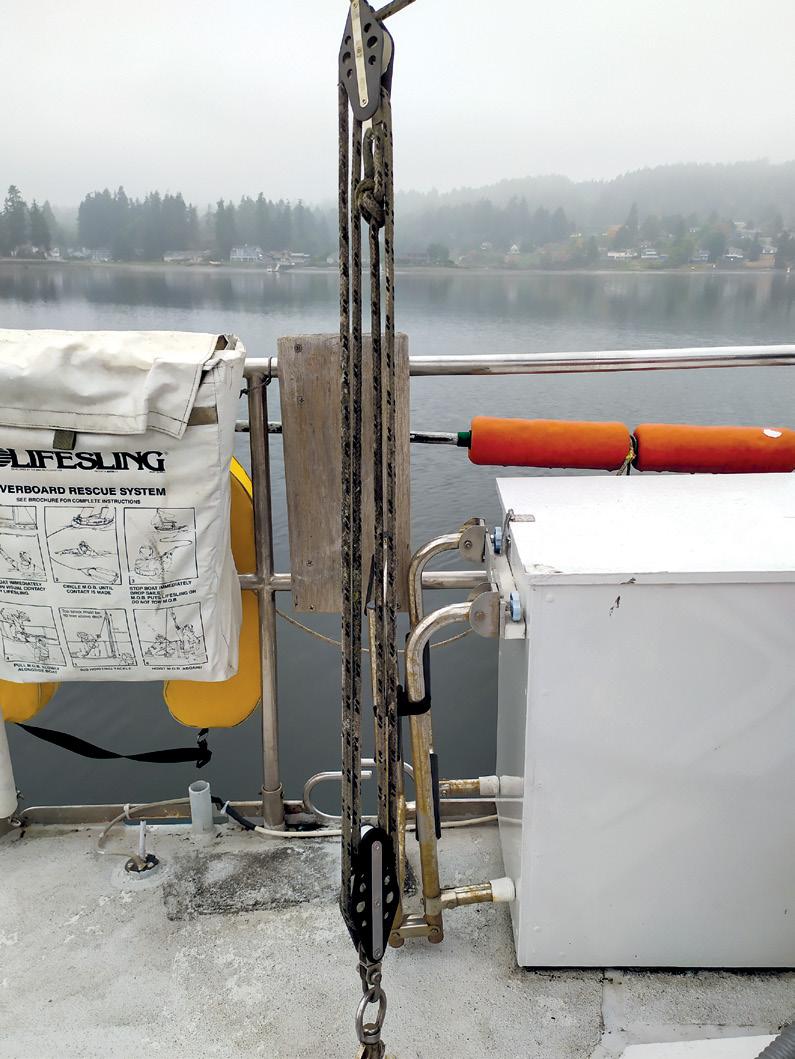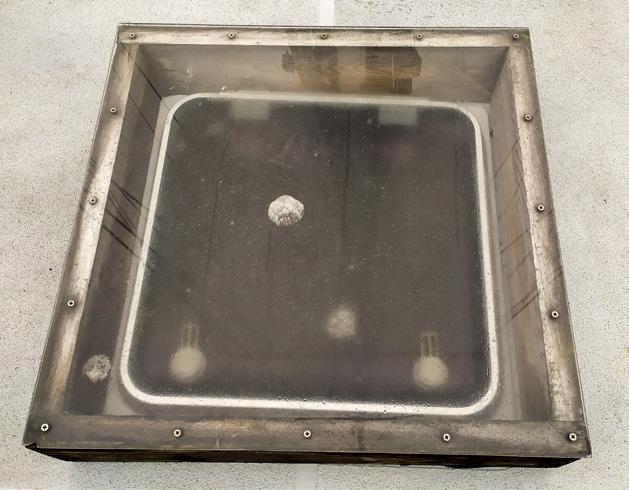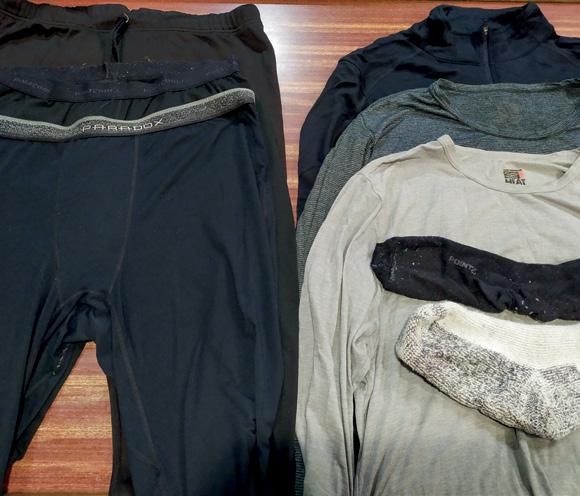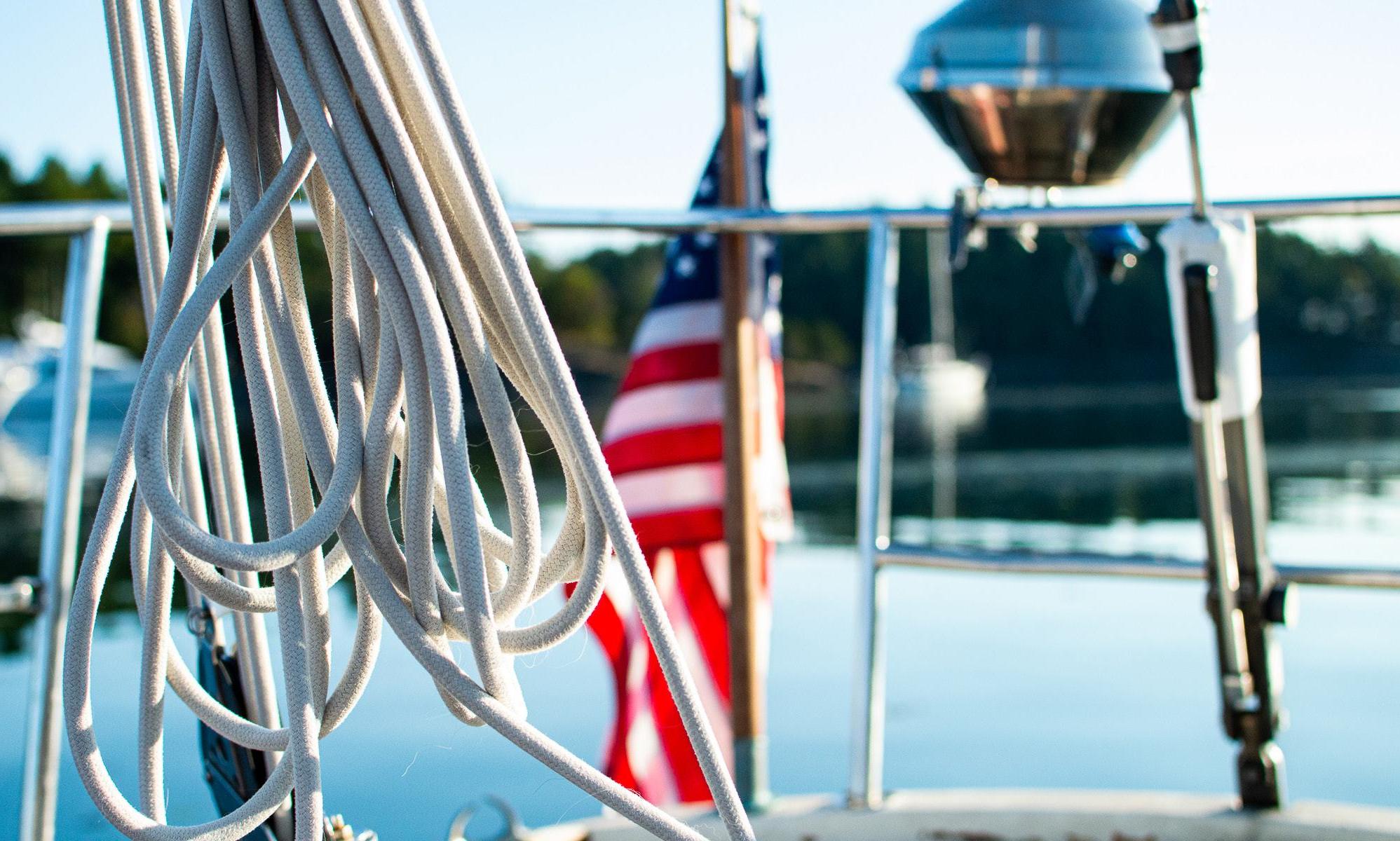
13 minute read
How-to: Redefine Winterizing
by 48° North
24 How-to “WINTERIZING’S” OTHER DEFINITION
PREPARING BOAT & BODY FOR Winter Sailing
by Alex and Jack Wilken
The days shorten. Hours of dark last longer than daylight. Cold winds and lower temperatures, you will be less pleased if you and wet becomes the norm. In our November 2011 article—“If do not keep faith with “Semper Paratus” or run afoul of old man You Must Winterize”—we talked about how to “winterize” your Murphy. Bigger breeze make it more likely for things to break or boat if you were not going to use it for several months. go wrong, and it increases unpleasantness when they do. Lower
But what if winterizing didn’t mean buttoning up your boat temperatures change how we have to deal with many things in to sit unused for the winter? What if winterizing meant making order to keep them dry and functional, including our bodies. some maintenance and mindset changes and upgrades so that Winter sailing success begins with good maintenance practices you can better enjoy sailing throughout the winter? One of the and good seamanship. joys of the Pacific Northwest is that the sailing season doesn’t Part of this mindset shift is to think of fall as the ideal time truly end. You can sail all year, in almost any weather. to complete a major maintenance checklist. We often think of
If summer 2020 is any indicator, more folks will be on the doing boat maintenance in the spring after months of little to water this winter than ever before. Boating is clearly at the no time on the boat. Yet, if you plan to use your boat during top of the list of safe, socially-distanced, and highly enjoyable the windier season, autumn is exactly the right time to do your outdoor activities to enjoy during pandemic restrictions. And as most rigorous checks and preparations of the year. opportunities for other activities become limited in the winter months, sailing remains viable; some might even say it gets RIGGING*: STANDING AND RUNNING better! Never something that should be neglected, it’s doubly
Whether you’ve been more of a fair weather sailor or you’re important to ensure your rigging works well if it is to be under new to sailing—if you have limited winter sailing experience strain in winter winds. A full rigging inspection* is a good idea, and you plan to spend more time on the water through these particularly if you haven't checked it closely in a while. months, there are considerations for you and the boat that If you are thinking it might be time to replace part of the will keep everything comfortable, safe, dry, and happy. In this rigging, do so. Be proactive—that jib sheet with a little spot article, an asterisk (*) means that we've written a longer article that’s chafed or fraying is easy to trust in a light summer on the subject for 48° North over the years. northerly, but may well wreak havoc in a blustery November southerly (Figure 1). MINDSET There are a handful of winter sailing realities that influence
It all begins with mindset. “Semper Paratus” (Always Ready) equipment choices, including in the rigging realm. First, windier is the Coast Guard motto. “If it can go wrong, it will” is Murphy's conditions not only put more wear on gear, but often mean that Law. As many sailors will tell you, Murphy was a sailor. These things happen with less convenient timing—sometimes slower are always things to keep in mind when boating, but in higher than ideal (making a sail change), sometimes MUCH faster (just 48º NORTH 24 OCTOBER 2020
about anytime things start to go wrong). Knowing this motivates us to employ rigging systems that improve ease and efficiency in ways that make sailors safer and happier.
This leads into the second winter sailing reality: it can be tougher to find crew in the winter, whereas your friends may be clamoring for a ride in the height of summer. Shorthanding skills and thoughtful system set-up can help you sail more, and more safely, all year round.
If you’ve been thinking about running lines back to the cockpit so no one has to go forward to handle them*, do so. Servicing or installing roller furling* can keep you and your crew from having to go forward to deal with the headsail, and can sometimes increase your options for sail area reduction with roller reefing.
Lazy jacks* and/or a low friction hoist system* each make dealing with the mainsail easier. Either or both are worthwhile considerations. Reefing* is obviously more important in higher winds and should always be practiced first at the dock. It’s a good idea to go out with a reef in on a windy day—shaking a reef out later is easier than putting one in. The maintenance prep for your reefing system is simple, and involves ensuring the lines are run, connected, and running smoothly. If your reefing system is not efficient, you could consider installing a one-line slab reefing system in advance of the winter season.
All of this is important because, eventually, leaks can compromise a boat’s structural integrity.
VENTILATION*
At the dock or on your hook for an extended cruise, staying on the boat in cool weather increases the problem of condensation on the interior. The results can range from frustrating (drips from a hatch onto your sleeping face) to dangerous (pervasive mold and rot). The two ways to deal with condensation are by insulation and ventilation.
Hatches are particularly prone to condensation as they lose a lot of heat and the air cooling on the pane of the hatch then condenses the moisture that the air can no longer hold on the inside of the hatch. A simple solution to this is to insulate the hatch with a hatch cover (Figure 2). These can be cloth or can be built out of wood and Plexiglas*. Cracking a hatch at each end of the boat allows for good ventilation but needs to be balanced with heating and heat loss. As all things in boats, finding the right balance is the key.
Dehumidifiers are a useful tool in combating condensation as long as you have the AC power to run them, so they are less useful away from the dock. Between your cruises, running a dehumidifier and a small heater can help the boat stay dry and ready for your next adventure.
CABIN HEAT* CLOTHING FOR COLD AND FOUL WEATHER
For day sailing, you do not necessarily need onboard heating It could be said that the only thing you really need for winter if you are treating sailing like going on a hike. Get on the boat sailing that you don't need for summer sailing is multiple with gear to be comfortable while sailing, then come back to the layers of warm, moisture-wicking clothing and a more robust dock and warm up and dry off. But if you want to go overnight or waterproof shell. A boat in good seagoing order will probably anchor out, or simply wish to have a warm cabin while sailing, be fine. Dressed appropriately, you could be comfortable sitting you need some sort of heating on the boat. in the cockpit, exposed to cold rain, driving wind, and spray for
A wall-mounted diesel cabin heater may be the simplest and hours on end. among the most common, but there are many other options It sounds most unappealing when stated as such, but it is, including diesel, propane, and even wood-burning systems. in fact, one of the great joys of winter sailing: to go out and Some options, notably hydronic heating systems, may also test your skill and your boat in something other than a summer provide hot water. Short of a dedicated system, most hot water breeze. “A ship in harbor is safe, but that's not why ships are tanks are electric and do not work when you’re not plugged into built,” as John Shedd’s saying goes. It is a most exhilarating shore power (unless you have a generator). sensation to get back in from sailing and having to suddenly get layers off because you are now too hot. While you were out ADDRESS YOUR LEAKS* sailing, you were perfectly comfortable.
This could be the most important thing to get done before So how to stay warm and dry when surrounded by cold and it starts raining. In good weather, we tend to forget about that wet? Start with this: winter sailing is a winter sport. To go skiing, leak that was bothering us last winter because we moved the hiking, mountaineering, or camping in the winter, you’d expect bowl underneath it since it hasn't been needed for months. to wear a lot of clothing, some of it sport-specific, to safely
Some of the worst ones to find and fix are those that don't and comfortably enjoy this winter sport. So it is with sailing. show up until after a few days of rain, or even worse that stop Sailing may even be somewhat more complicated, because it after a few days of rain and only leak when it has been dry for is primarily a sedentary activity with intermittent fits of sweata while and the rain first starts. Use any rain that we get to start creating exertion. On top of that, you might have water flying at the hunt for leaks. Using a hose from the dock will often not find you not only from the sky, but also as spray from the sea around the stubborn ones, but can help you locate many of the others. you. That’s not to say that it’s not worth the effort (quite the
If you don't get a leak fixed before it starts to rain a lot, mark it opposite!), but it does mean that being adequately geared up is so you know exactly where it is, normally on the inside. To fix it, essential to comfort and safety. you can tarp just that area to dry it out so you can deal with it. If The first rule when selecting sailing gear is to remember: you tarp it off and it doesn't stop, you know the leak isn't coming “cotton kills!” We were out sailing once on a boat and the through somewhere outside of where you thought it was. It can captain was literally wearing sandals and no socks and one of become a slow process of elimination to locate the leak. us had the proper sailing boots with cotton socks... Oh, such 48º NORTH 25 OCTOBER 2020
very cold feet, and not the captain’s. We’re not recommending this—the point is that cotton will make you much colder when wet because it collects moisture and holds it next to your skin. It should be avoided entirely when choosing winter sailing gear.
Under your waterproof foul weather gear, you’re looking for multiple layers that either wick moisture away from your skin, provide insulation even when wet, or both. Wool moves moisture away from the body and keeps you warm if it’s wet. Many fleeces provide a similar function. Generally, you’ll be better off with more thin layers, both for wicking attributes and for laying versatility. We think the most important of these is the wicking base layer—a wool blend is our choice (Figure 3) but there are also synthetic alternatives. If you are cold, try adding a base layer. If you keep adding mid-layers it can get bulky very quickly, but you can keep adding base layers until you are no longer cold. Our standard is to bring at least one more layer than you can possibly imagine needing.
Funny enough, socks should also have a base layer. The US military has spent a great deal of time and effort to identify the ideal sock combination. And their answer seems to be a very thin sock against the skin, also called a sock-liner, and a thick sock over it for insulation, both wool obviously.
Gloves are a bit of a conundrum. We want them to keep our hands warm and dry and protected from the lines yet not reduce our dexterity. We have yet to find a glove that does all of these things perfectly. Rubber is the most waterproof but tends to reduce dexterity and is not insulative. Neoprene is much more insulating than rubber, but a truly waterproof glove that does not reduce dexterity is elusive. One solution we have found to work rather well is an old-style fingerless wool glove with removable mittens to cover the fingers (Figure 4). Being wool, they keep your hands warm even when wet. You can remove the mittens to use the fingers to untie a knot or secure a shackle, and they are easy to take off and put back on. There is a reason this design has been around so long. If you’re doing a lot of line handling though, you may go through them quickly.
If you want your boat to be ready for winter sailing, perhaps the simplest way to go about it is simply to keep sailing frequently. Taking the boat out regularly provides benefits to you and the boat.
One of my favorite and most memorable sails ever was on a T-Bird out on Lake Washington after a big snow. There was snow on the deck, the sheets were frozen, crushed ice was left in heaps next to the winches. There were only two other boats out there. Mt Rainier was in crystal clear view, and we had it practically all to ourselves. With proper planning and outfitting, this and much more is available to sailors around the Pacific Northwest in the coming months. * For a linked list of the related archives, please visit 48north.com
Alex and Jack Wilken are lifelong cruisers, professional shipwrights, USCG licensed captain, and the owners of Seattle Boat Works.


Figure 2: Cabin heat is great, but with the temperature differential between your toasty cruising abode and the chilly out-of-doors, condensation can be a real challenge. One way to address hatches (which are particularly underinsulated and prone to condensation) is to consider a hatch cover—either cloth or a rigid structure like this one.
Figure 1: Winter sailing can expose problems in your rigging. If you have old, chafed, or fraying lines, fall is a good time to replace them in advance of winter winds.
48º NORTH


Figure 3: Multiple baselayers, a heavy pairs of socks with a wicking sock layer underneath them, and these gloves that look like they belong in Charles Dickens novel—all are components of staying as dry as possible, and warm no matter what when winter sailing.
26 OCTOBER 2020
TODAY! SUBSCRIBE

PREMIUM 48° NORTH SUBSCRIPTION
Become a part of the 48° North crew! In addition to your magazine each month, with this exciting new subscription offering, you’ll also be supporting 48° North in a more meaningful way. But, warmed cockles are far from the only benefit. Others include: • Discounts at Fisheries Supply Co. • One free three-day to the Port Townsend Wooden Boat Festival ($40 value) • 10% off of Northwest Maritime Center classes excluding Sailing Club • Discounts on registration fees for events • Cool bumper sticker and decals. • $75/year (additional fees for First Class forwarding or International)
JUST THE MAGAZINE, PLEASE:
Our standard subscription gets you 12 months of 48° North and its associated special publications (SARC, Setting Sail, and the Official R2AK Program). • $39/year (additional fees for First Class forwarding or International)
Subscribe today online: 48north.com/subscribe
MAHINA OFFSHORE SERVICES












